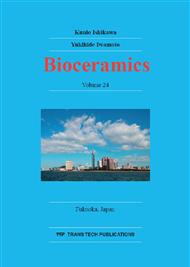[1]
T. Hanawa, M. Ota, Calcium phosphate naturally formed on titanium in electrolyte solution, Biomaterials 12 (1991) 767-774.
DOI: 10.1016/0142-9612(91)90028-9
Google Scholar
[2]
D.J. Wever, A.G. Veldhuizen, J. de Vries, H.J. Busscher, D.R.A. Uges, J.R. van Horn, Electrochemical and surface characterization of a nickel-titanium alloy, Biomaterials 19 (1998) 761-769.
DOI: 10.1016/s0142-9612(97)00210-x
Google Scholar
[3]
T. Hanawa, M. Ota, Characterization of surface film formed on titanium in electrolyte using XPS, Appl. Surf. Sci. 55 (1992) 269-276.
DOI: 10.1016/0169-4332(92)90178-z
Google Scholar
[4]
T. Hanawa, O. Okuno, H. Hamanaka, Compositional change in surface of Ti-Zr alloys in artificial bioliquid, J. Jpn. Inst. Metal. 56 (1992) 1168-1173.
DOI: 10.2320/jinstmet1952.56.10_1168
Google Scholar
[5]
J.L. Ong, L.C. Lucas, G.N. Raikar, R. Connatser, J.C. Gregory, Spectroscopic characterization of passivated titanium in a physiologic solution, J. Mater. Sci. Mater. Med. 6 (1995) 113-119.
DOI: 10.1007/bf00120418
Google Scholar
[6]
Suyalatu, N. Nomura, K. Oya, Y. Tanaka, R. Kondo, H. Doi, Y. Tsutsumi, T. Hanawa, Microstructure and magnetic susceptibility of as-cast Zr-Mo alloys, Acta Biomater. 6 (2010) 1033-1038.
DOI: 10.1016/j.actbio.2009.09.013
Google Scholar
[7]
N. Nomura, Y. Tanaka, Suyalatu, R. Kondo, H. Doi, Y. Tsutsumi, T. Hanawa, Effects of phase constitution of Zr-Nb alloys on their magnetic susceptibilities, Mater. Trans. 50 (2009) 2466-2472.
DOI: 10.2320/matertrans.m2009187
Google Scholar
[8]
T. Hanawa, S. Hiromoto, K. Asami, O. Okuno, K. Asaoka, Surface oxide films on titanium alloys regenerated in Hanks' solution, Mater. Trans. 43 (2002) 3000-3004.
DOI: 10.2320/matertrans.43.3000
Google Scholar
[9]
Y. Tsutsumi, D. Nishimura, H. Doi, N. Nomura, T. Hanawa, Difference in surface reactions between titanium and zirconium in Hanks' solution to elucidate mechanism of calcium phosphate formation on titanium using XPS and cathodic polarization, Mater. Sci. Eng. C 29 (2009).
DOI: 10.1016/j.msec.2009.01.016
Google Scholar
[10]
T. Hanawa, Biofunctionalization of titanium for dental implant, Jpn. Dent. Sci. Rev. 46 (2010) 93-101.
Google Scholar
[11]
H. Ishizawa, M. Ogino, Characterization of thin hydroxyapatite layers formed on anodic titanium oxide films containing Ca and P by hydrothermal treatment, J. Biomed. Mater. Res. 29 (1995) 1071-1079.
DOI: 10.1002/jbm.820290907
Google Scholar
[12]
Y. Han, S.H. Hong, K.W. Xu, Structure and in vitro bioactivity of titania-based film by micro-arc oxidation, Surf. Coat. Technol. 168 (2003) 249-258.
DOI: 10.1016/s0257-8972(03)00016-1
Google Scholar
[13]
F. Liu, F.P. Wang, T. Shimizu, K. Igarashi, L.C. Zhao, Formation of hydroxyapatite on Ti–6Al–4V alloy by microarc oxidation and hydrothermal treatment, Surf. Coat. Technol. 199 (2005) 220-224.
DOI: 10.1016/j.surfcoat.2004.10.146
Google Scholar
[14]
W. Ma, J.H. Wei, Y.Z. Li, X.M. Wang, H.Y. Shi, S. Tsutsumi, D.H. Li, Histological evaluation and surface componential analysis of modified micro-arc oxidation-treated titanium implants, J. Biomed. Mater. Res. 86B (2008) 162-169.
DOI: 10.1002/jbm.b.31002
Google Scholar
[15]
J.Y. Suh, B.C. Janga, X. Zhu, J.L. Ong, K.H. Kim, Effect of hydrothermally treated anodic oxide films on osteoblast attachment and proliferation, Biomaterials. 24 (2003) 347-355.
DOI: 10.1016/s0142-9612(02)00325-3
Google Scholar
[16]
W.W. Son, X. Zhu, H.I. Shin, J.L. Ong, K.H. Kim, In vivo histological response to anodized and anodized/hydrothermally treated titanium implants, J. Biomed. Mater. Res. B Appl. Biomater. 66B (2003) 520-525.
DOI: 10.1002/jbm.b.10042
Google Scholar
[17]
Y. Yan, Y. Han, Structure and bioactivity of micro-arc oxidized zirconia films, Surf. Coat. Technol. 201 (2007) 5692-5695.
DOI: 10.1016/j.surfcoat.2006.07.058
Google Scholar
[18]
Y. Han, Y. Yan, C. Lu, Ultraviolet-enhanced bioactivity of ZrO2 films prepared by micro-arc oxidation, Thin Solid Films. 517 (2009) 1577-1581.
DOI: 10.1016/j.tsf.2008.09.064
Google Scholar
[19]
Y. Yan, Y. Han, C. Lu, The effect of chemical treatment on apatite-forming ability of the macroporous zirconia films formed by micro-arc oxidation, Appl. Surf. Sci. 254 (2008) 4833-4839.
DOI: 10.1016/j.apsusc.2008.01.117
Google Scholar
[20]
Y. Tsutsumi, D. Nishimura, H. Doi, N. Nomura, T. Hanawa, Cathodic alkaline treatment of zirconium to give the ability to form calcium phosphate, Acta Biomater. 6 (2010) 4161-4166.
DOI: 10.1016/j.actbio.2010.05.010
Google Scholar
[21]
J.Y. Ha, Y. Tsutsumi, H. Doi, N. Nomura, K.H. Kim, T. Hanawa, Enhancement of calcium phosphate formation on zirconium by micro-arc oxidation and chemical treatments, Surf. Coat. Technol. 205 (2011) 4948-4955.
DOI: 10.1016/j.surfcoat.2011.04.079
Google Scholar
[22]
Y. Tanaka, E. Kobayashi, S. Hiromoto, K. Asami, H. Imai, T. Hanawa, Calcium phosphate formation on titanium by low-voltage electrolytic treatments , J. Mater. Sci. –Mater. Med. 18 (2007) 797-806.
DOI: 10.1007/s10856-006-0004-2
Google Scholar


